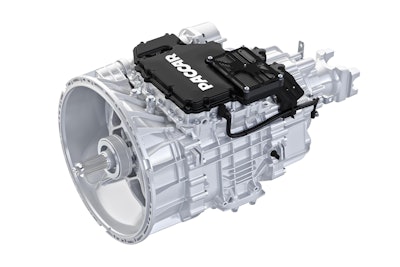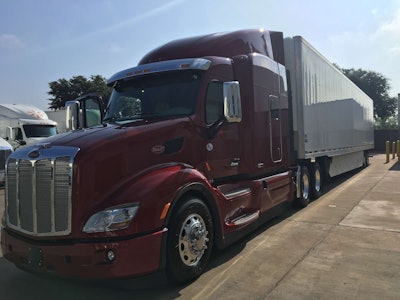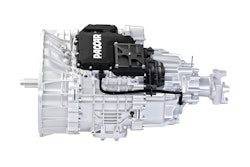
The introduction of an automated transmission signals both Kenworth’s and Peterbilt’s transition to its first built in-house gearbox for the T680 Advantage and Model 579 Epiq, respectively.
That transition, at least from my perspective on the Texas highway, should be as smooth as the transmission’s shifting. Sales of AMTs have soared the past three years among the two brands and AMTs have been spec’d in almost 60 percent of Model 579 orders this year. That’s up from 55 percent in 2016, which was up from 40 percent in 2015.
I took the new gear gearbox – outfitted in a Peterbilt Model 579 EPIQ and matched to a 455hp MX-13 engine – for a 120-plus mile spin around Decatur, Texas earlier this month.
The fruits of a three-and-a-half-year development program with Eaton, the Paccar automated transmission was made available for order in late August with an expected mid-October build date, and will be manufactured in Eaton’s San Luis Potosi, Mexico plant.
The 12-speed transmission – rated at 1,850 lb. ft. of torque and 110,000 GCVW and featuring standard eight-bolt PTO capability – isn’t a manual design with automated components. It is purpose-built as an automated transmission, which is why you won’t hear Paccar Powertrain engineers refer to it as an AMT.
The absence of an oil cooler, its lightweight aluminum construction and a lube system that only needs 16 pints of oil shaves about 200 pounds off the weight of a Fuller Advantage transmission and makes Paccar’s entry the lightest automated unit on the market.
 I tested Paccar’s new transmission in a Peterbilt Model 579 Epiq.
I tested Paccar’s new transmission in a Peterbilt Model 579 Epiq.Paccar included an industry-exclusive oil pressure sensor in its design in place of a sensor that only provides temperature. The new sensor will cause a derate, allowing the truck limp in first gear once the pressure sensor gets a low-fluid warning. This offers improved burn-up protection as the sensor does more than just warn the driver of the problem. It takes action to keep it from getting worse.
A column mounted shifter places controls at driver’s finger tips, increasing focus on the road and surround traffic. I prefer the column shift as opposed to the console-mounted cobra head or selector buttons in just about every case. It improves ergonomics with better access to more controls, and it also allows for the integration of the three-stage engine brake, which can be activated by pushing the selector switch downward.
It’s also frees up space on the dash-panel, allowing for better placement of other switches.
The Paccar transmission’s 18.85 gear ratio translates to better startability and lower RPM at cruising speeds. While the smoothness of the transmission certainly stands out, the quiet, intuitive and seamless shifts – coupled with low-speed maneuverability – really steal the show.
An “Urge to Move” feature prevents the truck from rolling in the wrong direction at start, and allows the driver to use the brake to control truck speed.
You don’t often find a friendly traffic fighter in a heavy truck, but that’s the feel you get from the Urge to Move function.
With the truck in drive and by lifting your foot off the brake, the truck starts to roll forward, even fully loaded on a grade as steep as 15 percent. As the cars in front begin to gain distance, you can manually upshift to quickly close the gap without touching the accelerator. You can also downshift manually as the need arises. When you reapply the brake, the transmission downshifts as you would expect.
This feature also works in reverse. When backing up, you can creep toward the dock, bumping between high and low reverse gears as needed. You don’t have to feather the accelerator and risk smacking the dock with an ill-timed fuel-fired lurch.
I was loaded to nearly 80,000 pounds and pushed the trailer up a small grade slowly but effortlessly.
When you need to come up to speed quickly, the transmission skip-shifts through the first eight gears based on torque needs, the road grade and the load. Capping the skip shift feature at eighth gear lets the tractor build speed faster at both the top and bottom end, and reach a cruising speed of 65 MPH at about 1,100 RPM.
The transmission puts itself into neutral automatically when the air brakes are applied, giving a hurried driver a failsafe that the truck is parked and out of gear when they hop out of the cab.
The Paccar transmission – which provides a marginal yet measurable fuel economy improvement over the offerings it competes against in the order book – will be available only as a mate for the MX-13 engine initially, but can be spec’d with Paccar, Meritor or Dana rear axles, and comes with a 5 year/750,000 mile warranty that is about 50 percent longer than its next closest competitor.
Paccar’s entry into the transmission market may be new but the ingenuity and engineering that went into its design is that of a wily veteran, and the remarkable overall performance of the unit will warrant strong – and immediate –consideration for Kenworth and Peterbilt customers.











